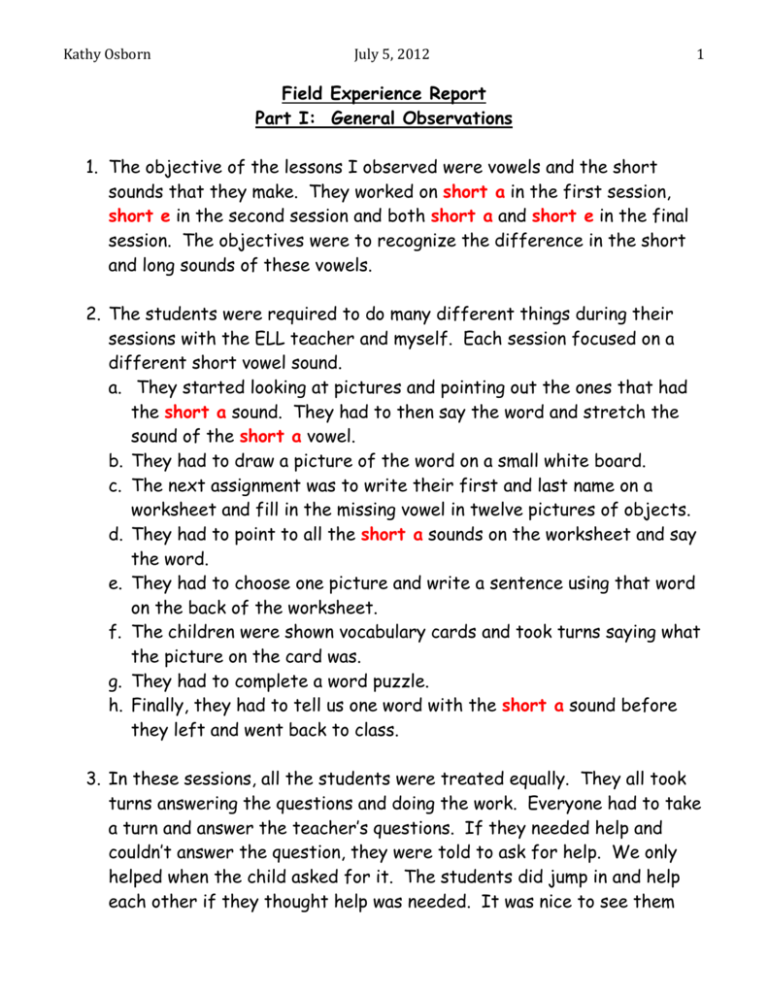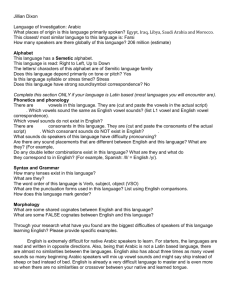Language Communication and Development Field Experience
advertisement

Kathy Osborn July 5, 2012 1 Field Experience Report Part I: General Observations 1. The objective of the lessons I observed were vowels and the short sounds that they make. They worked on short a in the first session, short e in the second session and both short a and short e in the final session. The objectives were to recognize the difference in the short and long sounds of these vowels. 2. The students were required to do many different things during their sessions with the ELL teacher and myself. Each session focused on a different short vowel sound. a. They started looking at pictures and pointing out the ones that had the short a sound. They had to then say the word and stretch the sound of the short a vowel. b. They had to draw a picture of the word on a small white board. c. The next assignment was to write their first and last name on a worksheet and fill in the missing vowel in twelve pictures of objects. d. They had to point to all the short a sounds on the worksheet and say the word. e. They had to choose one picture and write a sentence using that word on the back of the worksheet. f. The children were shown vocabulary cards and took turns saying what the picture on the card was. g. They had to complete a word puzzle. h. Finally, they had to tell us one word with the short a sound before they left and went back to class. 3. In these sessions, all the students were treated equally. They all took turns answering the questions and doing the work. Everyone had to take a turn and answer the teacher’s questions. If they needed help and couldn’t answer the question, they were told to ask for help. We only helped when the child asked for it. The students did jump in and help each other if they thought help was needed. It was nice to see them Kathy Osborn July 5, 2012 2 helping each other. I could not see any difference in the ELL students and the native English speakers. They all had an equal chance to answer questions. I could tell that this group was accustomed to working together and were a cohesive group. They had a certain rhythm about them and the way they worked together. They discussed where they would be sitting when they came to our room – they knew where to sit to be the first one to answer the questions. It was obvious that they enjoyed this time to work together. I thought they all interacted equally. There was no distinction between the ELL students and the native English speakers. I didn’t even know which children were the ELL students until after the first session when I asked the teacher. 4. There were just two teachers in this group with the students. I had spoken to the ELL teacher before joining her with the students. She told me that each child would get a chance to answer all the questions. The kids had been together so long that they knew just how the session would work. We both worked with the entire group of students. If she was working with one student because they needed help I went on with the other students. She had told me that this is how she wanted the session to be run – so I complied with her wishes. The students were able to try and help each other if needed. We watched while one of the ELL students helped a native English speaker. That kind of surprised me! Part II: Instructional Strategies Applied by the Candidate 1. The instructional goal of these lessons was: Students will be able to discriminate short vowel sounds. The objectives were: -to auditorily discriminate between the short a and short e vowel sounds. -to identify words with short a vowel sound -to indentify words with short e vowel sound These goals were part of the Massachusetts Common Core Standards RF.K.2 and RF.K.3. Kathy Osborn July 5, 2012 3 All of the activities that we did with the students were used to meet these goals. The students were required to locate, choose, write, draw, and speak the sound of short a and short e. All the students in our group were working on the same activities. 2. My job was pretty simple. The ELL teacher and I split up the activities between us. The assignment that I lead was to write their first and last name on a worksheet and fill in the missing vowel in twelve pictures of objects. I gave verbal instructions and general encouragement. The students had already been working on these skills and didn’t really need much help. I did have to help sound out a few pictures with both the ELL and native English speakers. I also lead the group in completing a word puzzle. The students sounded out the clues and I had to assist both groups occasionally. I also let the students help each other. I only stepped in if no one in the group could sound out the clue. The whole group worked together to complete the work puzzle. 3. I was very happy with the success of my sessions with this group. I was able to assist the ELL teacher and allow her to go even further with these students working towards her goals. I don’t work a lot with kindergarten students and I had to step back and remember that they were not quite reading yet. I usually teach first and second grade and they are much better at sounding out words that they don’t know. I had to assist with the sounding out of the short vowel sounds. The students were happy to be working with me because they know I am the computer teacher. I made it into a game to show me what they knew already about the short vowels sounds. Because I made it into a game – they were thrilled to play it with me. They took turns answering the questions and were very willing to help their peers. If I had more time, I could have brought the group into the computer lab and worked on some more skills with some of the software and websites that I have found. If it weren’t the end of the year, I would have had time to do that. I feel that this field experience has highlighted all the work ELL students have to do to learn a second language. I will definitely be more aware of this when I am teaching next year.




